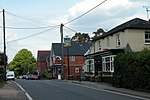Weaversdown Halt railway station
Weaversdown Halt railway station is a former railway station, on the Longmoor Military Railway, which served the eastern side of Longmoor Military Camp. The station did not appear on Ordnance Survey mapping throughout its life and did not have signs on the platform, it was variously known as Weaversdown, Weavers Down and Weaver Down sometimes with the additional Junction and sometimes with Halt.The station opened when the Longmoor Military Railway (LMR) extended its line to Liss, work started on the extension in 1924 and it was completed by August 1933.It is situated to the North of a branch curving away to the East and consisted initially of a passing loop with one platform built from sleepers being added later, there was a shelter and a block post, the Army's name for a signal box.The station was closed along with the rest of the line on 31 October 1969.
Excerpt from the Wikipedia article Weaversdown Halt railway station (License: CC BY-SA 3.0, Authors).Weaversdown Halt railway station
Kimberley Road, East Hampshire Whitehill
Geographical coordinates (GPS) Address Nearby Places Show on map
Geographical coordinates (GPS)
| Latitude | Longitude |
|---|---|
| N 51.07 ° | E -0.86 ° |
Address
Longmoor Ranges
Kimberley Road
GU33 6DH East Hampshire, Whitehill
England, United Kingdom
Open on Google Maps





